Is your business evaluating if it should move to the Cloud and migrate to Microsoft 365? Then you came to the right place! This post series will show you some of the top reasons to move to the Cloud and Microsoft 365.
Introduction
This two part blog post is the first part of a blog post series that will try to give you an idea of the advantages of moving to the Cloud and the benefits of adopting Microsoft 365 as a collaboration platform.
We live in a world that is rapidly moving towards Software as a Service (SaaS) solutions in several areas from collaboration, E-Commerce and many other areas, are moving from a reality where systems and respective data are deployed within the companies infrastructure (On-Premises) to the Cloud.
The goal of this two part blog posts is to give you an overview of the main features included in Microsoft 365 and how your organization can take advantage of them if you migrate to Microsoft 365.
These are the topics I will discuss in the first part of this two part blog post:
- Microsoft 365
- Collaboration with SharePoint and OneDrive
- Mobility
- Use Microsoft Teams as your Work Hub
- Easy and Secure External Sharing
To read the second part of this post, click here.
Microsoft 365
First things first! What is Microsoft 365?
One of the main concerns of companies in choosing a Cloud collaboration platform, in which the Microsoft 365 is an example and leading platform, is the security of their information. One of the biggest challenges when organizations are deciding if they want migrate to Microsoft 365 is related to the demystification that having the information in the Cloud is less secure than if it resides on the premises of the organizations themselves.
Microsoft has launched a licensing model that includes an impressive security feature set called Microsoft 365. This is a bundle that includes:
- Windows 10
- Office 365
- Enterprise Mobility + Security
This bundle comes in three different flavors:
The way I see it, Microsoft 365, in which Office 365 is a big part, has two main branches that are closely linked:
- Collaboration
- Security
The main purpose of Microsoft 365, is to empower business to collaborate in a secure way.
If you want to know more about all the security features included Microsoft 365, click here.
Below, is a summary of the top reasons why you should move to the Cloud and start using Microsoft 365. The summary is mainly focused on Microsoft 365 features.
Collaboration with SharePoint and OneDrive
Besides email, Microsoft 365 information will be stored either in SharePoint Online or OneDrive:
- SharePoint Online: the heart of collaboration in Microsoft 365 and where shared information in your organization should reside
- OneDrive: based on the same technology as SharePoint, it is a private space that allows each employee in the organization to store their personal documents. Each employee gets from 1 TB to 5 TB depending on the your licensing model
Office Web Apps (SharePoint and OneDrive)
With Microsoft 365, each Office application has a corresponding web app that allows you to collaborate on documents directly from the browser without the need of its corresponding Office client applications. These are the available Office Web Apps in Microsoft 365:
- Word Online
- Excel Online
- PowerPoint Online
- Visio Online
- OneNote Online
Each of this web apps allows you to open and edit documents directly from the browser. The experience is similar to the Office client application and there are just a few restrictions in edit experience (ex: you can open but not edit macro-enabled Excel files).
Real-Time Collaboration and Co-Authoring (SharePoint and OneDrive)
Are you tired of reviewing documents sending successive copies of the same document back and forth by email and not knowing what the latest version of the document is? Mee too and this is where co-authoring is a huge help!
When documents are stored in SharePoint or OneDrive, co-authoring allows you to share a document with users inside or outside your organization and have them collaborate on the document in real time without the need to save multiple versions of the same document and loose track of the changes that were made by each contributor. All contributions are merged into the same document and you can see who else is editing and what changes each contributor has made.
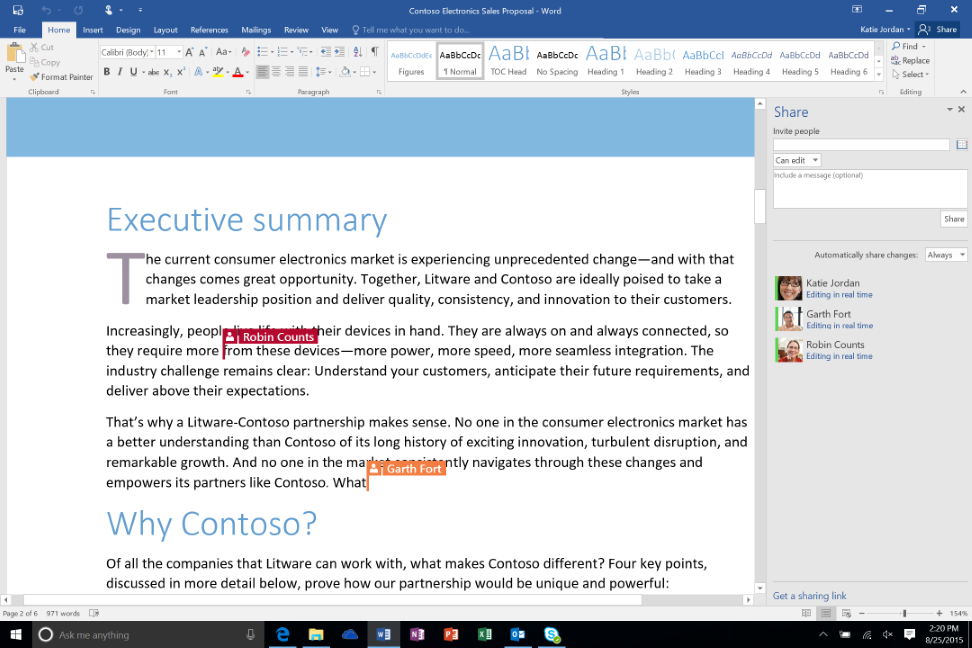

This allows you to have full real time collaboration over the same document instead of having multiple copies going back and forth by email, having the added advantage to significantly reduce the size of your mailbox and making you much more productive.
SharePoint and OneDrive take advantages of secure sharing, allowing you to choose who can access and edit the document.
To learn more about real time collaboration and co-authoring, click here.
Stop Sending Attachments by Email
Another advantage of using SharePoint and OneDrive for collaboration is that instead of attaching a copy of your document in the email, you can simply share a link to the document that is stored in SharePoint or OneDrive.


For users, the attachment looks exactly the same as a normal attachment with the difference of a having a small “cloud” symbol near the document icon.


This way, we also significantly reduce the size of user’s mailboxes since what we are sharing is the link do the document in SharePoint or OneDrive and not a copy of the file. Sharing documents this way also enables users to use real time collaboration by allowing them to co-edit the “attached” document. The document can be edited either in the browser or using the appropriate Office client application.
To learn more on Cloud Attachments, click here.
Offline Access
Documents in SharePoint and OneDrive are stored in document libraries. You can sync any SharePoint or OneDrive files to a folder on your computer where you can work directly in the files using File Explorer and you can even access and work on the files when you’re offline.
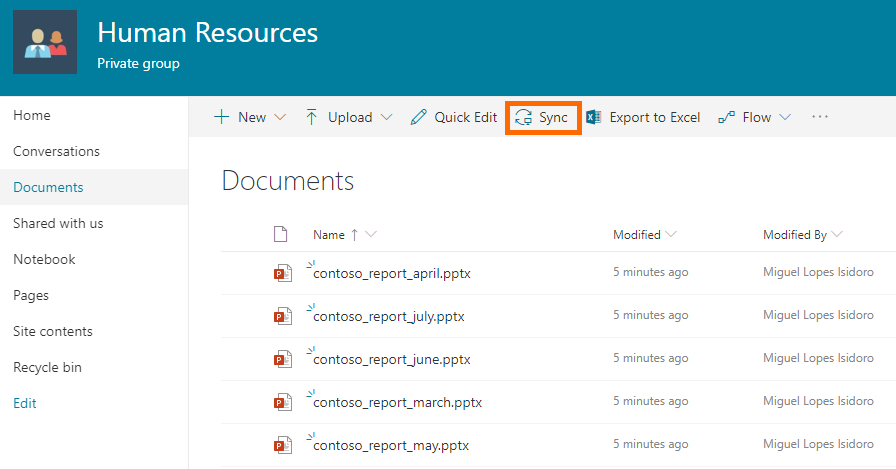



Once you get back online, any changes that you or other users make will be synced automatically.
To learn more on how to sync a SharePoint or OneDrive document library, click here.
Microsoft 365 Groups
Microsoft 365 groups are the preferred method for team collaboration in Microsoft 365. When created, an Microsoft 365 group provides the following for its members:
- A Security Group (Azure AD)
- A Shared Group Mailbox (Exchange)
- A Shared Team Site (SharePoint)
- A Shared Notebook (OneNote)
- A Team in Microsoft Teams (if created through Teams or if later a Team in Microsoft Teams is associated to an existing Microsoft 365 group)
- A Teamwork Planning Space (Microsoft Planner)
Microsoft 365 Groups can be created from a variety of ways in Microsoft 365 (among others: SharePoint, Outlook and Microsoft Teams) and its main purpose is to facilitate teams inside the organizations to collaborate. For instance, the Shared Group Mailbox that is created is not a distribution list but a shared mailbox in Exchange Online and it allows for a new member in the group to have instant access to all emails sent to the shared mailbox prior to his addition to the group!
To learn more about Microsoft 365 Groups, click here.
Mobility
One of the strongest advantages when you migrate to Microsoft 365 is mobility. You will be able to access your documents, emails, business processes from any device and from any location.
Below, are a few examples of what you can do directly from your mobile phone or tablet:
- Access your email and contacts using Exchange Online and Outlook Mobile App
- Open and collaborate on shared documents in SharePoint Team Sites using Office mobile apps (there is a mobile version for Word, Excel, PowerPoint, etc)
- Share and access important news with your team using SharePoint Communication Sites
- Access your organizations dashboards using Power BI
- Access important business processes (example: approve your team’s expenses) using PowerApps
- Join a meeting directly from your phone using Microsoft Teams mobile app
- Access relevant corporate information using the mobile SharePoint app
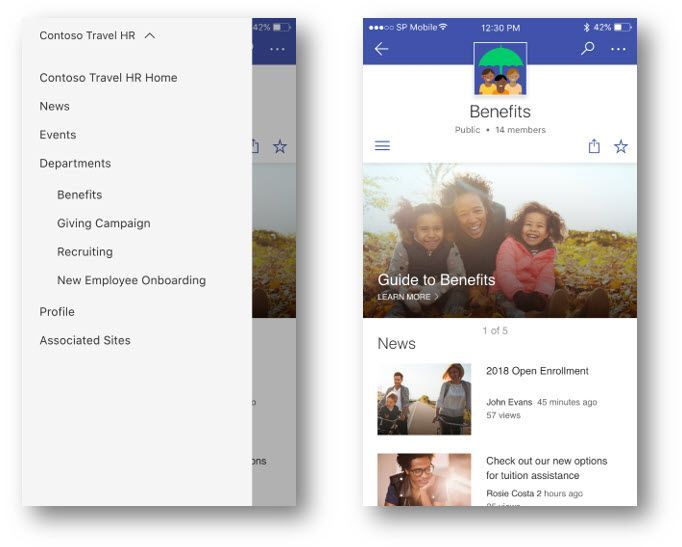

All of this can be achieved in a secure way. I will talk a little bit more on security later in the second part of the blog post.
Use Microsoft Teams as your Work Hub
Microsoft Teams is a collaboration platform that was launched on March 14, 2017 and it combines workplace chat, audio and video based conference call meetings, notes, attachments and all that relates to digital team work. This service integrates seamlessly with Microsoft 365 including Microsoft Office, SharePoint Online and can also integrate with non-Microsoft products.
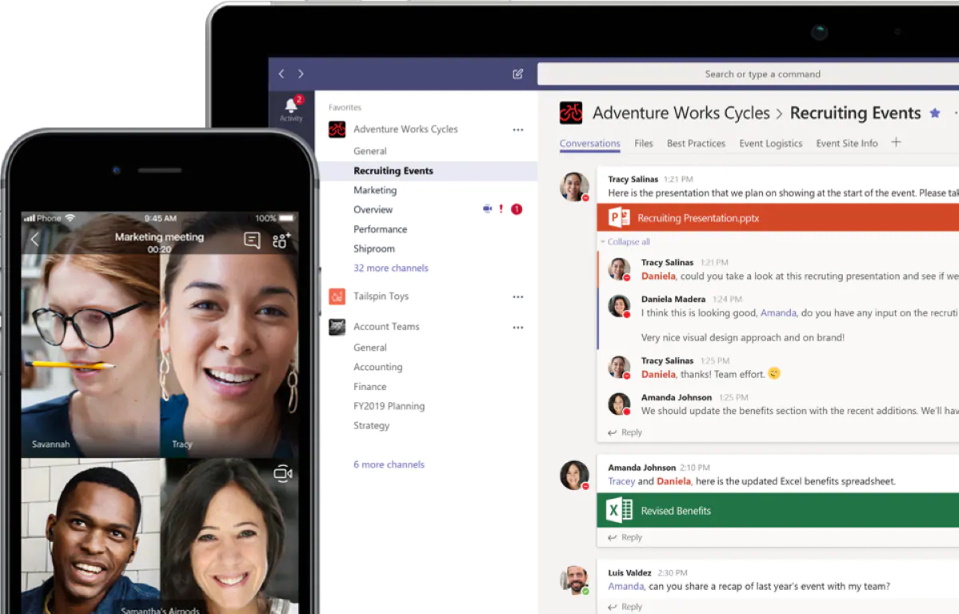

Microsoft Teams is already the fastest growing business app in Microsoft’s history and is rapidly growing to be the work hub for collaboration in Microsoft 365. In summary, Microsoft Teams provides:
- 1-to-1 and Team Chats: You can chat with any internal users in your Microsoft 365 tenant and also guest users (for more details, about internal users and external users and Pros and Cons of Single Tenant vs Multiple Tenants in Microsoft 365, click here)
- Channels: By default, a single channel called “General” is created for every Team but new channels can be created. The most common approach is to create a few channels, one for each relevant topic within the Team. For now, all channels share same security settings as the team but in the near future it will be possible to have private channels (with specific permissions)
- Meetings: You can organize and attend online meetings (audio and video) and you can even start your meeting using your PC and continue attending it using your mobile device. All you need is a stable internet connection!
- Files: You can open your files directly in Teams without the need to go to SharePoint where the files are stored. Soon, Teams will have the full SharePoint files experience and the user experience to interact with files will be even better than it is today (if you want to know more about the recent announcements on Teams, SharePoint and Microsoft 365, click here and here)
- Tabs: Tabs is a great way to add content to your Team or channel. It allows you to add new tabs that show content from Microsoft 365 (ex: a shared calendar, the Team Planner, a PowerBI dashboard) or relevant external content (ex: an external web page)

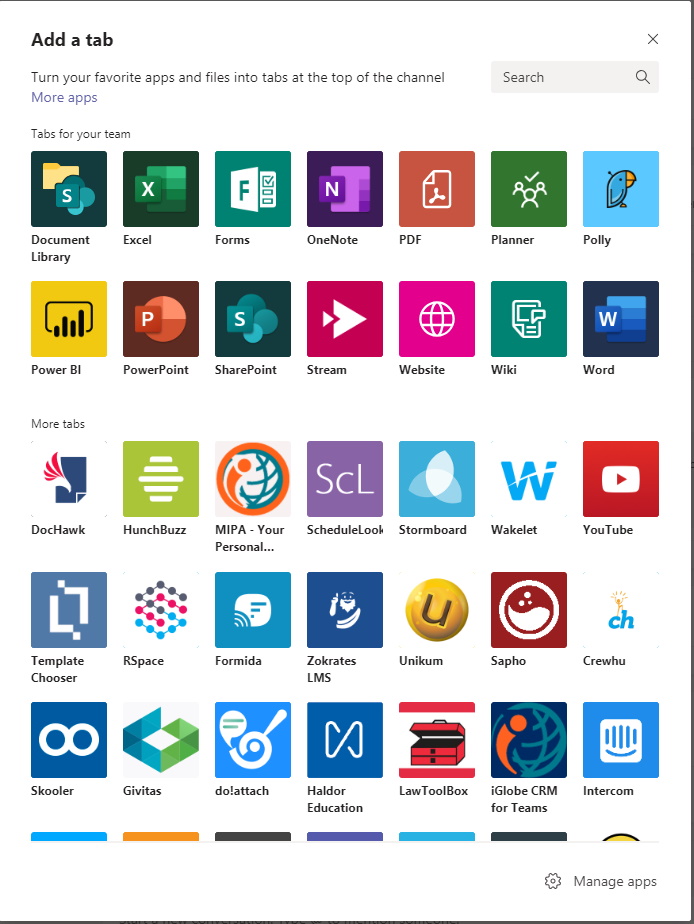
- Connectors: Similar to tabs but it allows you to get content from a variety of content sources directly into a channel (ex: a relevant RSS feed, Twitter account activity, etc)

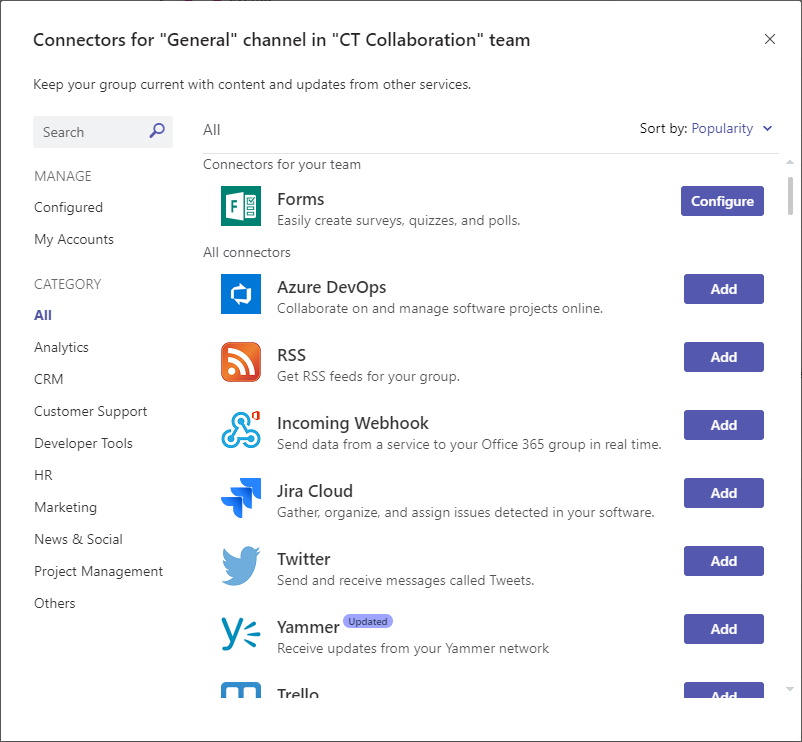
- Bots: Microsoft Teams also has the ability to communicate with Bots that are artificial intelligence applications which can complete simple or complex tasks using chat-based commands
- Mobile App: All the above can be done using the Teams Mobile app, which is a rich feature set app, available for IOS and Android
To learn more about Microsoft Teams, click here.
Easy and Secure External Sharing
For organizations to be able to share content from an On-Premises SharePoint installation, it involves some complex IT configurations to be set in place. If you migrate to Microsoft 365 and SharePoint Online, it gets much easier to share information with external users, allowing information to be easily shared in a secure way.
SharePoint Online makes it possible to easily share:
- Sites: Share a whole site with an external user
- Document Libraries: Share only the contents of a specific document library
- Folders: Share only the contents of a specific folder
- Documents: Share only the contents of a specific document
To be able to share with external users, external sharing must be enabled on the Microsoft 365 Admin Center and from a security perspective it is possible to control for which domains external sharing is allowed (either by using black or white lists).
To learn more about external sharing on Microsoft 365, click here.
To read the second part of this post, click here.
Related Articles
If you want to convert your tenant’s root classic site into a modern SharePoint site, click here.
If you are a SharePoint administrator or a SharePoint developer who wants to learn more about how to install a SharePoint 2019 farm in an automated way using PowerShell, I invite you to click here and here.
If you learn how to greatly speed up your SharePoint farm update process to ensure your SharePoint farm keeps updated and you stay one step closer to start your move to the cloud, click here.
If you prefer to use the traditional method to update your farm and want to learn all the steps and precautions necessary to successfully keep your SharePoint farm updated, click here.
If you want to learn how to upgrade a SharePoint 2013 farm to SharePoint 2019, click here and here.
If SharePoint 2019 is still not an option, you can learn more about how to install a SharePoint 2016 farm in an automated way using PowerShell, click here and here.
If you want to learn how to upgrade a SharePoint 2010 farm to SharePoint 2016, click here and here.
If you are new to SharePoint and Microsoft 365 and want to learn all about it, take a look at these learning resources.
If you are work in a large organization who is using Microsoft 365 or thinking to migrate to Microsoft 365 and is considering between a single or multiple Microsoft 365 tenants, I invite you to read this article.
If you want to know all about the latest SharePoint and Microsoft 365 announcements from SharePoint Conference 2019, click here and here.
If your organization is still not ready to migrate to Microsoft 365, a hybrid scenario may be the best choice. SharePoint 2019 RTM was recently announced and if you to learn all about SharePoint 2019 and all its features, click here.
Happy SharePointing!


![[FIX] BizTalk Server 2010, 2013, 2013 R2 & 2016 errors “Class not registered (WinMgmt)” or “Access denied”](https://blogit.create.pt/wp-content/uploads/2018/07/access-black-and-white-blur-270514-218x150.jpg)












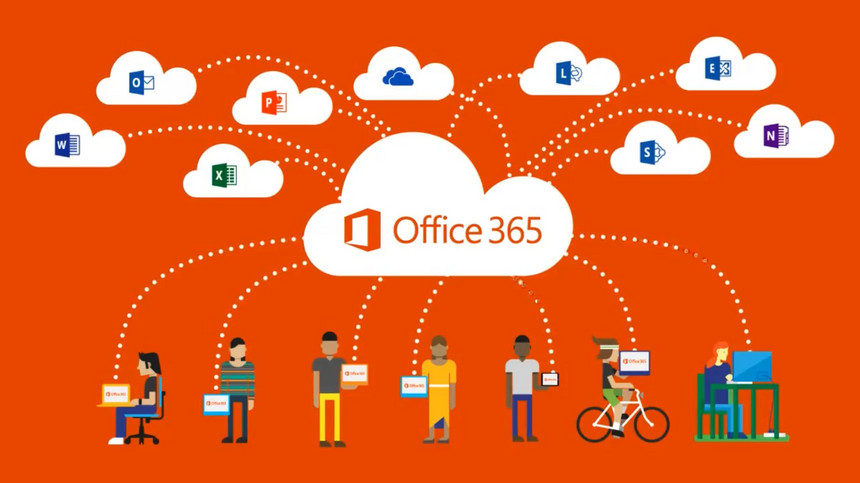



Interesting blog on SharePoint online, Keep it up. Please keep sharing
Thank you for your feedback!
Good to know this and very informative, thanks for sharing this Miguel.
Thanks for the feedback!
Wonderful post. This is excellent information you shared. It is amazing and wonderful post of SharePoint.
Thanks Kylie, I am glad you liked it and found it useful!
Recommendable post. I learn something more challenging on different blogs everyday. Helpful stimulating to see content from other writers and study a little something there. Let me apply certain of your content on my blog on hand mind. Natually Ill give you a link time for your web page. Appreciate your sharing.
Office 365 migration services in India
Thanks for your feedback!
Great and all unless you do anything other than default lists and libraries on sharepoint. They just sunset workflows and replaced with power automate which can’t even email a sharepoint group without a 10 step flow with REST calls and looping. You have custom sharepoint forms with 500 lines javascript? Forget that son, you get Infopath 2013, and you can try and hack your javascript into the infopath form in designer.
Hello Brian,
Things in fact have changed in the SharePoint world! The challenge we have is to adapt and build new solutions on top of the new developer stack (Power Platform, SPFx, etc).
It is a new development approach but a powerful one!
Thanks,
Miguel